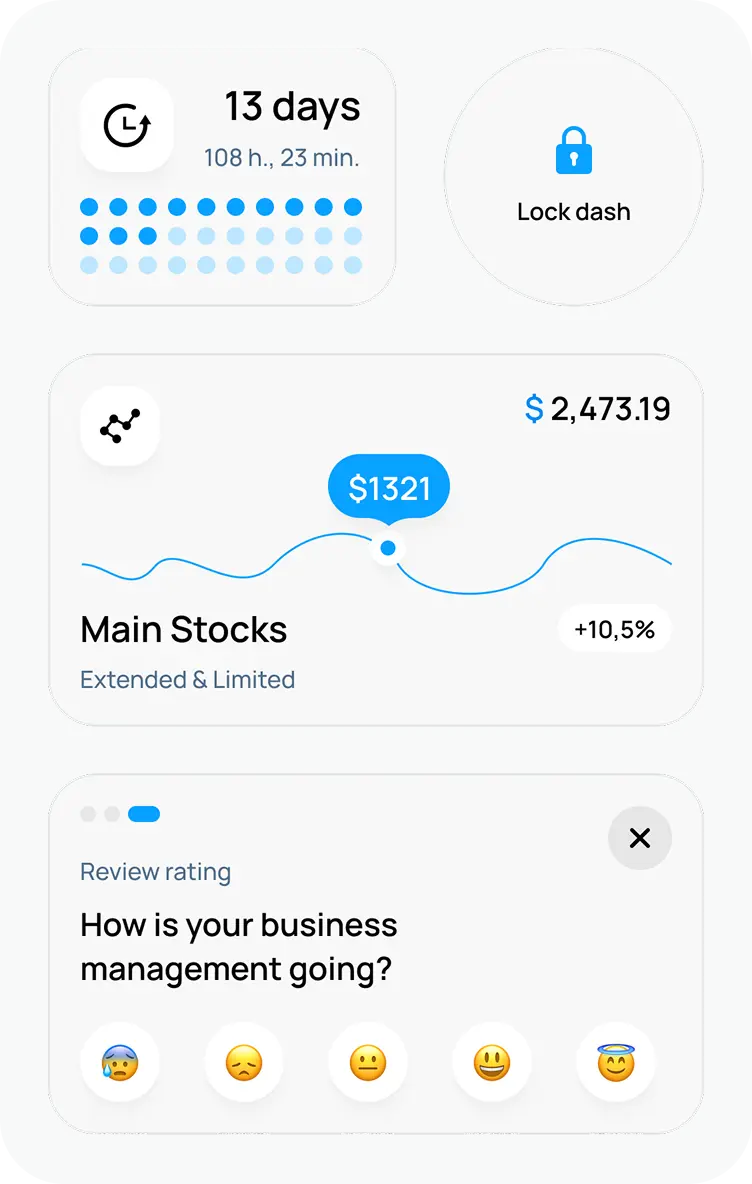Flutter vs React Native: Which technology should you choose in 2025?
April 7, 2025•11 min read

I hope you enjoy reading this post. If you want us to do your frontend development or design, click here.
Author: Alex Vasylenko | Founder of The Frontend Company


Flutter and React Native are two cross-platform frameworks that dominate the frontend industry. Both are built to support large-scale applications like Google Pay (Flutter) or Discord (React Native).
But how do you choose between them? The right answer depends on what your application values most: performance, scalability, third-party ecosystem, hiring complexity, or long-term maintainability. And that's just the beginning — each project has its priorities that can tip the scales.
In this article, I will step in as the judge in the Flutter vs React Native showdown, giving you a detailed breakdown of both technologies. The goal? To help you choose the right tool to scale or launch your product with confidence.
Flutter vs React Native: Difference and Goals
These frameworks approach the problem from fundamentally different angles.
Flutter is perfect for teams who want complete control over visuals and performance, especially in apps with custom design language, animations, or branding precision.
React Native is excellent for those who want to release fast, maintain stability, and work in the JavaScript ecosystem.
So, it's not about which framework is better or worse — it's about choosing a tactic for your app's future.
To make the right move, you need to understand more details about each technology. To make it easy, use this table, where we have added the core differences and goals of Flutter and React Native:
Category | Flutter | React Native | Comment |
|---|---|---|---|
1. Tech Stack | Dart | JavaScript (with JSX) | Impacts performance, developer experience, and hiring |
2. UI Components | Offers its own set of UI components (Material Design) | Use native UI components for iOS and Android | Flutter guarantees consistency; RN feels more native |
3. Performance | High out of the box, consistent across devices | Good, needs tuning for complex UIs | Flutter is more predictable; RN is flexible but variable |
4. Dev Speed | Fast with hot reload | Fast with hot reload + supports OTA | RN allows faster post-launch updates |
5. Code Sharing | Strong on mobile; web/desktop optional | Strong across mobile and web | RN is better for teams already using React on the web |
6. Learning Curve | Easier for native mobile devs | Easier for web/React devs | Choose based on your team’s background |
7. Ecosystem | Growing, curated, stable | Mature, massive, sometimes fragmented | Flutter = focus; RN = variety |
8. Scalability | Modular, clean architecture (e.g. Nubank) | Flexible integration into existing native apps (e.g. Discord) | Flutter suits full builds; RN fits gradual adoption |
9. Hiring | Smaller talent pool, high developer satisfaction | Larger talent pool, easier to hire | RN scales hiring faster; Flutter teams may be more specialized |
10. Future Outlook | Supported by Google | Supported by Meta | Both are stable, but Flutter pushes harder into multi-platform |
Not Sure Which Framework Fits Your Product Vision?
Yes, help me to make the right technical choice before I write a single line of code.
React Native vs Flutter: Which is Better For Your App
Let's get one thing straight — there's no pick-one-and-run situation. And if someone tells you, "Just use Flutter" or "React Native is the default," walk away. This choice requires more than Googling benchmarks or looking at GitHub stars.
Choosing between Flutter and React Native is choosing between two different approaches to build a product. Both can take you to the finish line — but depending on your team, product goals, technical details, and scaling plans, one may cost you less pain and money down the road.
When to Use Flutter
If your app is UI-heavy, with high design requirements, custom animations, or a strong focus on brand consistency, select Flutter. Why? Because you get pixel-perfect control across platforms.
It doesn't rely on native UI components — it draws everything itself. That means your app will look and behave the same on every device, down to the last pixel.
Examples where Flutter is a better pick:
You're building a fintech app with rich dashboards, smooth transitions, and a branded UI like Google Pay.
You need to target multiple platforms, including desktop or web, from one codebase.
Your mobile team has native experience (Android/iOS) and can adapt quickly to Dart's structure.
You want fewer platform-specific bugs and better long-term maintainability in UI logic.
But...
Dart isn't as common as JavaScript, so hiring may take longer. If you're already working in a JS-heavy stack, integrating Flutter might create a silo.
When to use React Native
React Native is a solid choice if your team is already using React, your web and mobile platforms need to share logic, and you want to get to market fast. It's flexible, battle-tested, and gives you access to a massive JavaScript ecosystem.
Examples where Flutter is a better pick:
You're launching an MVP or product that will evolve rapidly (think startups, internal tools, or customer-facing apps with fast iteration cycles).
You have a React web app and want to share logic/components with mobile.
Your dev team is mostly JavaScript/TypeScript focused.
You value the ability to push OTA updates without waiting on app store approval.
However, React Native apps can suffer from performance issues if not tuned properly, especially in complex UIs or animation-heavy scenarios.
You'll also deal with third-party library maintenance, occasional native bridge quirks, and the overhead of debugging across both JS and native layers. If you're not careful, things get messy fast.
How to choose between Flutter and React Native?
Start with a technical and UX Audit: look at your team's skillset, product roadmap, required platforms, and UI complexity.
Map those against the strengths and trade-offs of each framework — not just today, but 12–24 months down the line.
If you're unsure, run a lightweight proof of concept in both — it will expose gaps faster than any blog post ever will.
Build a small slice of your actual app — maybe a core screen, key animation, or API integration — using both frameworks. You'll quickly see where each one shines, where it struggles, and how your team handles the real-world development experience.
Why Leading Products Choose Flutter or React Native
When tech giants and fast-scaling startups choose a framework, it's never random — it's driven by product needs, team strengths, and long-term strategy.
Here's how some of the most well-known apps made their choice between Flutter and React Native — and what you can learn from it.
Google Pay → Flutter
Why Flutter? Google Pay needed to rebuild and unify its mobile experience across Android and iOS for over 100 million users. They chose Flutter to maintain full control over the UI, made a pixel-perfect design, and reduced duplicated engineering effort.
One codebase for both platforms
Improved feature velocity
Better consistency across devices
Flutter's performance handled real-time payments and animations smoothly
If your product has a complex, brand-driven UI with high usage volume, Flutter gives you tight control and consistent performance.
Nubank → Flutter
Why Flutter? Nubank, Latin America's largest digital bank, needed to scale fast while delivering a flawless user experience. They moved from native development to Flutter and saw massive productivity gains.
Developers could own full features (UI + logic) end-to-end
Faster onboarding for new engineers
Shared UI layer reduced bugs and boosted release speed
For companies scaling mobile products with fintech-level quality, Flutter allows teams to move faster without sacrificing reliability or design integrity.
Instagram → React Native (Partial)
Why React Native? Instagram gradually integrated React Native for features like the post-promotion tool. This allowed them to test RN in production, reduce native overhead, and accelerate feature delivery without a complete rewrite.
Incremental adoption strategy
Seamless integration into a native app
Faster time-to-market for certain features
React Native is ideal for incremental migration or when you want to test cross-platform dev without committing to a full switch.
Shopify → React Native
Why React Native? Shopify adopted React Native as the mobile standard for internal teams to unify web and mobile workflows.
React knowledge carried across platforms
Streamlined hiring and team training
Supported fast, test-heavy iteration cycles
If your company is heavily invested in the web, React Native lets you scale mobile without retraining your entire team.
Discord → React Native
Why React Native? Discord wanted to deliver a fast, dynamic mobile chat experience without maintaining two separate native teams. React Native gave them cross-platform speed without rebuilding everything from scratch.
Reused logic from their existing React web app
Shipped faster across both platforms
Leveraged RN flexibility with native modules for performance-critical areas
If your team lives in the JavaScript ecosystem and your app requires fast iteration with shared logic, React Native is what you need.


Transform your UI for peak performance!
🔹
Unlock seamless, high-performance frontend solutions tailored to your business.
🔹
Get an interface that outshines competitors and delights your users.
React Native vs Flutter in FinTech Apps with Heavy UI Animations
After discovering why big companies choose Flutter and React Native, let's look at some specific case studies to better understand which technology is right for your business.
In this case review, we want to compare Flutter and React Native in FinTech apps, as we have a lot of clients from this industry.
Good FinTech apps often have polished, highly interactive UIs with rich graphs of stock prices, card flip animations, and custom loaders – along with top-notch security. They also handle real-time updates (market data, etc.) but must remain smooth and responsive.
Flutter in FinTech:
Flutter is increasingly popular in fintech due to its ability to create branded, custom UI experiences. It renders every pixel with its Skia engine, so complex animations remain smooth if coded properly.
For example, a fintech app can use Flutter's animation libraries to create fluid chart interactions at 60 FPS. Flutter's advantage is that performance-intensive UI elements are done in native code (via Dart AOT), avoiding the lag of a JavaScript bridge.
Example: Nubank – the largest digital bank in Latin America – adopted Flutter to deliver a consistent, buttery-smooth UX in its mobile app. By using Flutter, Nubank achieved faster feature launches and improved UI consistency across Android/iOS, all while reducing build times.
Their developers reported that animations and custom components were easier to implement and maintain in Flutter than in their previous approach.
FinTech teams also appreciate Flutter's hot reload during development – they can iterate on intricate UI designs in real time, tightening the feedback loop for UI/UX refinement.
React Native in FinTech:
Heavy animations in React Native can be achieved via libraries like Reanimated or by offloading work to native, for example, using a native charting SDK and wrapping it in React Native. But, very animation-heavy screens (e.g., a live updating candlestick chart with lots of animations) could expose React Native's bridge overhead, leading to dropped frames.
However, the newer architecture and JSI reduce that overhead, and it's possible to run animations at 60 FPS by using optimized techniques. There are successful cases of React Native in finance – for instance, Robinhood in earlier days used React Native for certain features, and Coinbase has used React Native for some internal tools.
React Native and Flutter Pros/Cons for FinTech with heavy UI:
Flutter Pros:
Great for custom, graphically rich UIs — charts, gradients, shaders, and animations run smoothly without performance issues.
Consistent design across platforms, ensuring a unified brand experience on both iOS and Android.
Faster time-to-market when targeting multiple platforms with a single codebase.
Some fintech companies even use Flutter Web for admin panels, reusing business logic and UI components.
Strong community adoption in fintech, which means more vetted packages for encryption, secure storage, charting libraries, and biometric authentication
Flutter Cons:
Dart is less common in fintech circles, so you may need to invest in training or hire developers with Dart experience.
Integration with niche native libraries (e.g., biometric auth, HSMs) may require building custom Flutter plugins if community support is lacking.
The app binary size can be slightly larger than a fully optimized native app:
Basic Flutter app: ~5.6 MB
Basic React Native app: ~8 MB
React Native Pros:
Taps into the massive JavaScript ecosystem — share models, logic, and even UI components between web and mobile.
Great for fintechs with existing React web apps, enabling faster rollout with shared validation, APIs, and business logic.
Rich library ecosystem for real-time charts, animations, and device features.
A larger pool of experienced JS/React developers makes it easier to hire and scale engineering teams quickly.
Supports OTA updates, allowing teams to patch bugs or release small features instantly without waiting for app store approval.
React Native Cons:
Performance tuning for complex animations can require extra engineering — developers may need to optimize threads or offload tasks to native.
Heavy reliance on third-party modules, which may break during framework or OS updates — requires proactive testing and dependency management.
Multiple banks and payment apps like Google Pay, Nubank, and Credit Agricole's apps chose Flutter for its UI capabilities and cross-platform efficiency.
On the other hand, React Native can absolutely be used for fintech, but to match Flutter's visual fidelity, it may require more careful engineering.
For core banking features that rely on device hardware — like scanning a check using the phone's camera — React Native often has mature, well-maintained community packages ready to use.
Flutter typically has equivalent packages, but they may be newer or less battle-tested, so you'll want to evaluate their reliability before using them in production.
Flutter vs React Native in Chat Apps
The next example is how Flutter and React Native perform in chat apps that most of us use every day. They should include quick updates, background storage for messages, and smooth scrolling through thousands of messages. And these two frameworks can help with that, but it different ways.
React Native in Chat Apps:
I repeat myself, but Discord is a flagman example as they built their iOS and Android apps with React Native, delivering a feature-rich chat (text, voice, video) experience to millions of users.
React Native allows their team to write reusable code, learn from each other, and move fast with a two-person team. Additionally, it gives them the flexibility to move fast, build their interface with JavaScript and React, and drop into native code only when truly needed.
If you already have a React web app, React Native can help to share logic between web and mobile and release your mobile chat app in weeks.
Flutter in Chat Apps:
Flutter is also very capable for chat – its rendering performance is a big plus when dealing with long scrollable lists of messages or animated reactions.
Big players like Alibaba have used Flutter in apps with chat-like feeds, and smaller companies like Hookle have successfully built social-feed-style chat experiences.
A key advantage is that Flutter doesn't use a bridge between the UI and the logic like React Native does. That means incoming messages (real-time updates via sockets or streams) trigger fast widget rebuilds directly in Dart — no waiting on a JS-to-native round trip. With Flutter's efficient rendering engine, these updates feel instant, even when the message list is long.
If you're building:
A one-to-one messenger
A group chat with read receipts, typing indicators, or message reactions
A feed with comments and real-time updates
Flutter can handle all of that, especially with tools like Stream's Flutter Chat SDK, which gives you production-ready components for chat UIs, message lists, and socket connections.
And when it comes to deeper OS-level integration — like quick replies from notifications, sharing media into the app, or background message handling — Flutter can access all of that using platform channels or community-maintained plugins.
Flutter and React Native Pros/Cons for Real-Time Chat:
Flutter Pros for Chat Apps
High FPS with heavy UI elements like animated stickers or transition effects.
Consistent UI behavior across Android and iOS, and fewer platform-specific bugs.
Hot reload speeds up UI iterations — great for fine-tuning chat bubbles, animations, and gestures.
Built-in GestureDetector makes custom interactions (e.g., swiping to reply) simple and cross-platform.
Multi-platform support — compile the same UI to mobile, desktop, or web (ideal if you're planning Slack/Discord-like expansion).
Flutter Cons for Chat Apps
No OTA update support out of the box — slower response to live issues or critical patches.
If your org already uses React for web chat, you'll need to maintain separate codebases (unless you rewrite the web in Flutter Web).
App size can be heavier for very simple apps.
Some OS-specific chat features (iOS interactive notifications, Android chat bubbles) may require custom native code — fewer plug-and-play modules compared to RN.
React Native Pros for Chat Apps
Easier learning curve and potential logic/component sharing via React Native Web.
Well-established ecosystem for chat features — lots of mature libraries and blog coverage (push/in-app notifications).
Supports complex features like VoIP and audio/video chat using native modules like WebRTC or Twilio.
Third-party SDK support is strong — services like Twilio, Vonage, and Stream offer ready-to-use React Native integrations.
React Native Cons for Chat Apps
UI performance under heavy load can drop if the JS thread is busy (e.g., handling media, rendering, and messages simultaneously).
Requires careful use of FlatList and virtualization settings to manage long chat histories efficiently.
Debugging async issues (lag, memory leaks) is more complicated due to RN's hybrid architecture.
Compared to Flutter's single-language model, performance profiling and debugging are more complex in RN.
To summarize, both frameworks can help to create a high-quality chat app. React Native has proven itself in Discord, which indicates its viability. Flutter offers equally strong performance and might even have an edge in developer iteration speed for UI-heavy features.
If React were to build, say, the next WhatsApp or Slack from scratch with a cross-platform team, Flutter could offer a slight performance cushion (no worries about dropping to native for ultra-smooth scrolling) and a unified code strategy for mobile and desktop.
Flutter and React Native Hiring Challenges
After you pick the right technology, you need people who know how to use it well. But hiring them comes with its own set of challenges, including:
1. Developer Availability
In today's market, finding React Native developers is generally easier than finding Flutter developers. React Native draws on the giant pool of JavaScript/React engineers since the programming model (React components, JSX, and Redux) is familiar.
Flutter developers, on the other hand, require knowledge of Dart and widget tree paradigms. According to industry observations, skilled Flutter devs have been harder to find in recent years, simply because the technology is newer.
2. Cost of Hiring
More available RN developers can sometimes mean lower salary demand, but top-tier React Native engineers (who can navigate complex native integrations) still command premium rates. Flutter being in demand and with fewer experts can mean Flutter dev salaries are equal or higher.
For instance, some CTOs report that to hire an experienced Flutter team lead, they often have to pay a premium because that skillset is hot and slightly niche.
3. Organizational Complexity
For Flutter, you may need to set up new build pipelines and adopt a new language for mobile. For React Native, you integrate with existing JavaScript practices (which might mean aligning mobile release cycles with web deployment practices, etc.).
In terms of team structure, both allow you to have a single mobile feature team that delivers features on both platforms, which reduces duplicated effort and keeps feature parity in sync.
One pitfall to avoid: some companies using React Native fall into a hybrid setup, where RN is added into an otherwise native app, creating fragmentation over time.
Flutter, on the other hand, typically encourages a clean, single codebase from the start, making team ownership and architecture more straightforward.
Flutter vs React Native: Business Tips
Both Flutter and React Native are production-ready, widely adopted, and well-supported by major companies. There's no wrong answer — but there is a right one based on your business context.
If you're a startup needing to iterate fast with an existing React team, React Native wins.
If you're an enterprise investing in a long-term product with high UX expectations, Flutter is your best bet.
Some companies even use both — Flutter for polished consumer-facing apps and React Native for internal tools or MVPs, where speed matters more than perfect visuals.
To give you even more information, here are business tips for React Native and Flutter:
Flutter Tips:
Choose Flutter when design consistency matters. It gives you pixel-perfect control and smooth animations across platforms — ideal for fintech, branded consumer apps, or anything UI-heavy.
Think long-term platform expansion. Flutter can scale from mobile to desktop and web using the same codebase — great if you plan to build more than just a mobile app.
Great fit for native mobile teams. If your developers come from iOS/Android, they'll feel at home with Flutter's structure and get more out of its tooling and performance tuning.
React Native Tips:
Choose React Native when speed and flexibility are the priority. Fast iteration, OTA updates, and easy onboarding for React/web developers make it ideal for MVPs or rapidly evolving products.
Perfect for web-heavy orgs. If your frontend is already in React, React Native lets you reuse logic, components, and developer expertise across web and mobile.
Larger dev pool = easier hiring. If you need to scale your team quickly or tap into existing JavaScript experience, RN gives you an edge on resourcing.
Conclusion
Both Flutter and React Native are proven choices for production apps at scale – your decision should hinge on aligning the technology to your business context.
If you are a tech startup aiming for the fastest prototype with web and mobile parity, and you have React skills on hand, React Native gets you there quickly.
If you are an enterprise building a long-lived, design-heavy application and want full control over the user experience, Flutter provides a robust, future-forward foundation.
There's no shortcut — but there is a smart path: evaluate your roadmap, your team's strengths, and the scale of your ambition.
Still unsure which direction to go?
Book a free strategy call with The Frontend Company — and get guidance from engineers who've actually built and scaled real products in both frameworks.

Unlock the full potential of your product

Boost customer retention & satisfaction

Become more competitive on the market

Move to the latest technologies stacks

Improve usability & visual appeal
FAQ

Alex Vasylenko is the founder of The Frontend Company, DBC and several other successful startups. A dynamic tech entrepreneur, he began his career as a frontend developer at Deloitte and Scandinavia's largest banking company. In 2023, Alex was honored as one of 'Top 10 Emerging Entrepreneurs' by USA Today.
RATE
Rate this article please
This will help us provide more useful information.
792 ratings, average 4.99 out of 5
